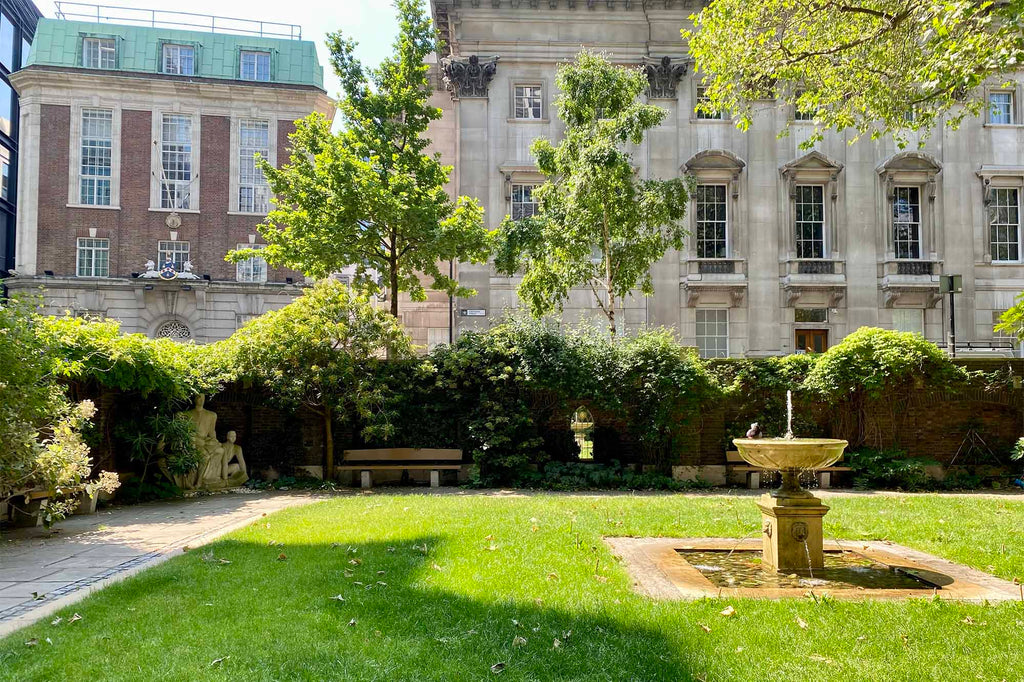Secret Gardens: Goldsmiths' Garden, City of London
Posted by SECRET GARDENER

Where the legacy of London's past is celebrated amidst the blooms and foliage.
Amidst the bustling streets of the inner City of London, it’s hard to imagine there are many public gardens you haven’t heard of. Goldsmiths’ Garden, nestled behind a brick wall on Gresham Street, is one such hidden gem – a tranquil green space, largely unknown to many, offering a peaceful escape from city streets. But what’s the story behind this garden, and where did it come from?
The History of Goldsmiths’ Garden
Goldsmiths’ Garden, as its name suggests, is intimately connected to The Worshipful Company of Goldsmiths: one of London's ancient guilds with a rich history dating back to 1327. As one of the Twelve Great Livery Companies they own the garden, and their headquarters are just a stone’s throw away.

Above: The Corporation of London's Blue Plaque.
The garden itself sits in the old churchyard of St. John Zachary, destroyed by the Great Fire of London in 1666. This Church was one of the few not rebuilt after the fire, unlike its neighbours Christchurch Greyfriars Church and St Dunstan-in-the-East.
Why is there a leopard’s head in Goldsmiths’ Garden?
There are several golden signs hidden around the garden, each with the face of a leopard. There are two embedded in the brick wall by the stairs, and a few more watching the gate to the garden entrance. A mirror mounted on the wall inside the garden has a face ever-present in the onlooker’s view. Curious these faces may appear, but they are in fact the trademark of the Goldsmiths’ Company.

Above: A leopard's head in the garden
In 1300, a statute was passed by King Edward I calling for precious metals such as gold and silver to reach a benchmark standard of high quality. Tests on metals were to be carried out, and those that passed were marked with a leopard’s head – also known as the King’s mark – which was the beginning of ‘hallmarking’ in Britain. The Company’s role within the goldsmiths’ trade had the right to enforce and emphasise this statute over all precious metals.
What to see in Goldsmiths’ Garden
Goldsmith’s Garden sits across two levels: a sunken courtyard garden with a manicured square lawn and a small flat plain at street level, where there are gravestones from the original churchyard. The garden was refurbished in the mid 1990s by the Worshipful Company of Gardeners, who have since won many awards for the garden’s flowers.

Above: The awards won by the Worshipful Company of Gardeners
We visited the garden in late spring, and again during the summer. The planting scheme makes good use of structural evergreen plants to bring interest year-round, but in the summer an additional array of colour emerges.

Above: A corner of the garden in March (left) and again in June (right)
Summer invites you to enjoy the fragrant flowers in their prime. The wall in the sunken garden is surrounded by climbing plants such as the white flowered Solanum laxum with, Callistemon Bottlebrush plant with its dramatic red spikes, and contrasting yellow rambling roses. There is a towering rhododendron that blooms in the spring, alongside daffodils, purple periwinkles, bluebells, and holly-leaved hellebore with pale green flowers.

Above: the vibrant bottlebrush flowers red in the garden during the summer months
The statue of The Three Printers
In the corner of the garden sits a large statue depicting three men. The Three Printers by Wilfred Dudeney is the only public monument to newspapers in Britain, and was commissioned by the Westminster Press Group. It was originally placed in New Street Square in Holborn, but when this was redeveloped it moved to Goldsmiths’ Garden in 2009.

Above: The Three Printers by Wilfred Dudeney
As a living tribute to the craftsmanship and history of the Goldsmiths’ Company, Goldsmiths’ Garden is a place where history and horticulture harmoniously coexist.
Whether you're a passionate gardener, a history enthusiast, or simply seeking a moment of respite, this hidden gem invites you to explore, appreciate, and connect with the vibrant life that thrives within its walls.

Above: the garden is located on the corner of Noble Street, where the original London Wall can still be seen.
How to get to Goldsmiths’ Garden
There is a large metal gate on Gresham Street that marks the entrance to Goldsmiths’ Garden, and a path from Noble Street next door which also provides access. Access to the garden is not step free.
Nearest tube: St Paul’s
Entry: Free
Opening hours: 24 hours a day
Goldsmiths’ Garden
Corner of Noble Street and Gresham Street
London, EC2V 7HN

